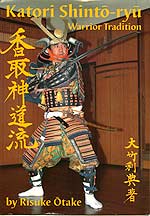Book Review
Katori Shinto Ryu: Warrior Tradition
By Risuke Otake

Clothbound, 7.25" x 10.25", 317
pgs. Illus. $75.00
Reviewed by Deborah Klens-Bigman
Koryu Books deserves a great deal of credit for bringing us a revised
and updated version of a martial arts classic: Risuke Otake's The Deity
and the Sword (originally published in 1977, most recent reprint 1991),
an in-depth description of Japan's oldest continuing martial arts tradition.
The 3-volume set was required reading for many (especially those of us
who studied Japanese swordsmanship) and until the advent of this new volume,
was a genuinely expensive, hard-to-find item. The new book combines all
three volumes into one, and has been revised and updated with new photographs,
including a few of American Donn Draeger, who studied Katori Shinto Ryu
in the 1970's. There are also many new photos depicting the techniques
that are outlined in the text.
As the author emphatically states, Katori Shinto Ryu is not a manual
of instruction. Only auxiliary practices, such as tachi rei (bowing to
the sword) and the esoteric religious techniques associated with the ryu
are described in detail. In fact, though there are many photos of techniques
for sword, bo (long stick), naginata (glaive) and empty-hand techniques,
among others, Otake points out that these are examples of the omote (surface)
applications only; the truly practical ura (hidden) techniques are not
shown, and are reserved only for initiates to the ryu. A careful look
at some of the illustrations bears this out – though Katori Shinto
Ryu is a nice introduction to the tradition, anyone wishing to study will
not find much to truly guide them here. This is a deliberate strategy
– teachers in traditional ryuha have become increasingly sensitive
about unauthorized transmission of teachings, concerned that improper
or incorrect techniques will be taught, thereby damaging the reputation
of the ryuha.
On the other hand, there is considerable detail with regard to certain
esoteric practices, including photos of the various mudra (hand signs)
used for spiritual empowerment. To those not familiar with Japanese religious
practices it may seem strange to find a style closely affiliated with
a Shinto shrine (the Katori Shrine in Chiba prefecture) also employing
esoteric Buddhist practices as part of its curriculum; however, a great
deal of blending was apparent in Japanese religions up until the Meiji
Period (1868-1912). To a certain extent, this blending still takes place
(Japanese people often are married Shinto or even in Christian, chapel-style
weddings, but many funerals are Buddhist; visiting the local Shinto shrine
at New Year is a very old tradition, yet if you ask many people directly
they will state their religious affiliation as Buddhist). It should be
noted, however, that the practices described by Otake are not necessarily
followed by other ryuha, nor are they considered part of mainstream, modern
Buddhism.
Overall, Katori Shinto Ryu is beautifully laid out, with helpful notes
in the margin explaining some of the obscure terms used in the text that
would not translate well into English. Once again, Koryu Books' excellent
editors have created a rare pleasure in the publishing world: a clear,
readable text that is free of the typos and syntax errors that I encounter
all too often. I also deeply appreciate that the original bilingual format
has been retained. Like Koryu Books' other offerings, Katori Shinto Ryu
has the feel of something that is lovingly hand-produced. I would have
liked a glossary and index, but that is a very small quibble in a text
that is so well and clearly presented.
Though it may seem a little steep at $75.00, the price is very low considering
the quality production and number of photographs. Now there is no excuse
not to have this classic work on every martial artist's bookshelf.
This book is available from:
Koryu Books
P.O. Box 86
Berkeley Heights, NJ 07922-0086
http://koryu.com
About The Reviewer:
Deborah Klens-Bigman is Manager and Associate Instructor of iaido at
New York Budokai in New York City. She has also studied, to varying extents,
kendo, jodo (short staff), kyudo (archery) and naginata (halberd). She
received her Ph.D in 1995 from New York University's Department of Performance
Studies where she wrote her dissertation on Japanese classical dance (Nihon
Buyo). and she continues to study Nihon Buyo with Fujima Nishiki at the
Ichifuji-kai Dance Association. Her article on the application of performance
theory to Japanese martial arts appeared in the Journal of Asian Martial
Arts in the summer of 1999. She is married to artist Vernon Bigman. For
FightingArts.com she is Associate Editor for Japanese Culture/Sword Arts.
|